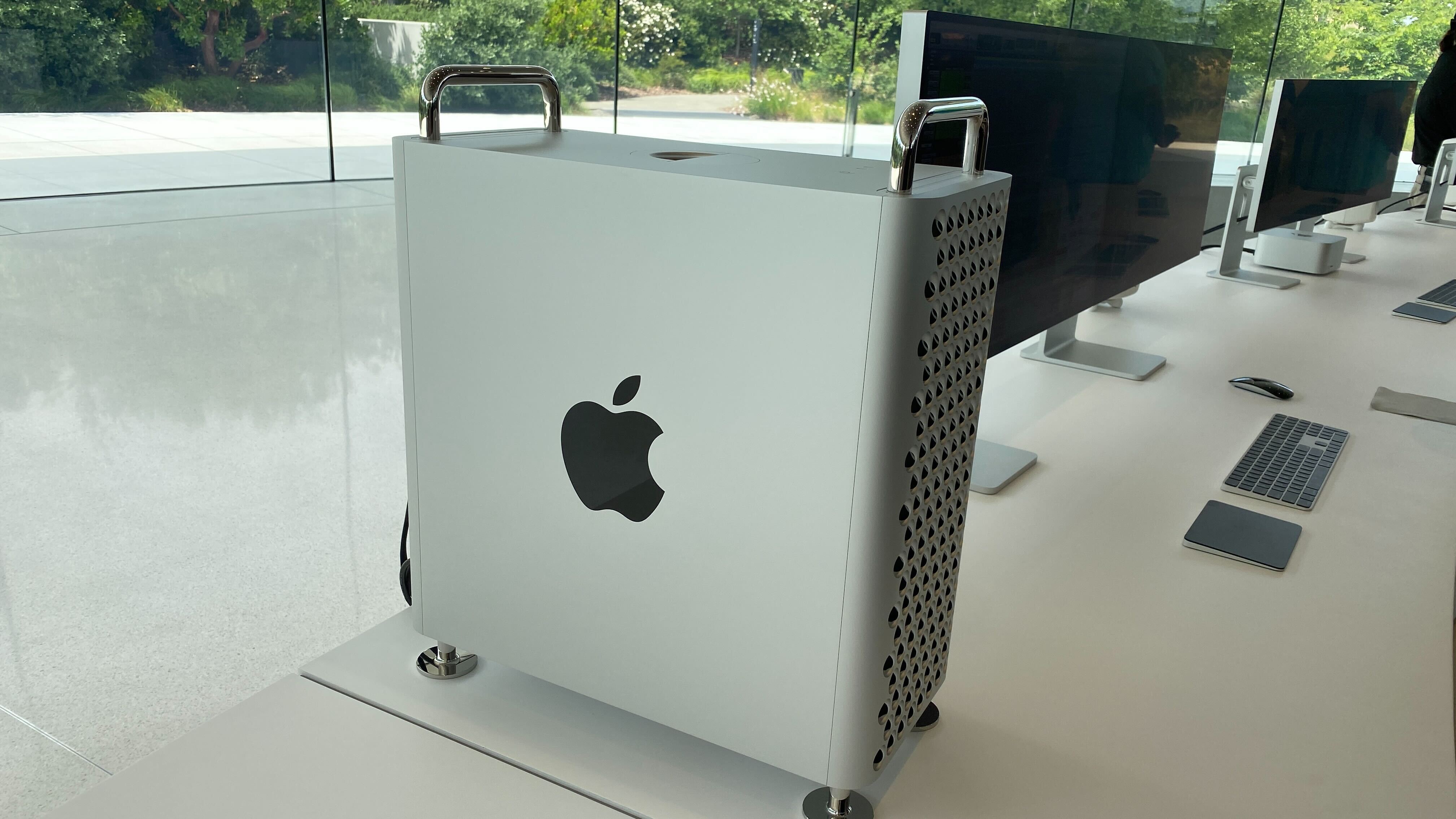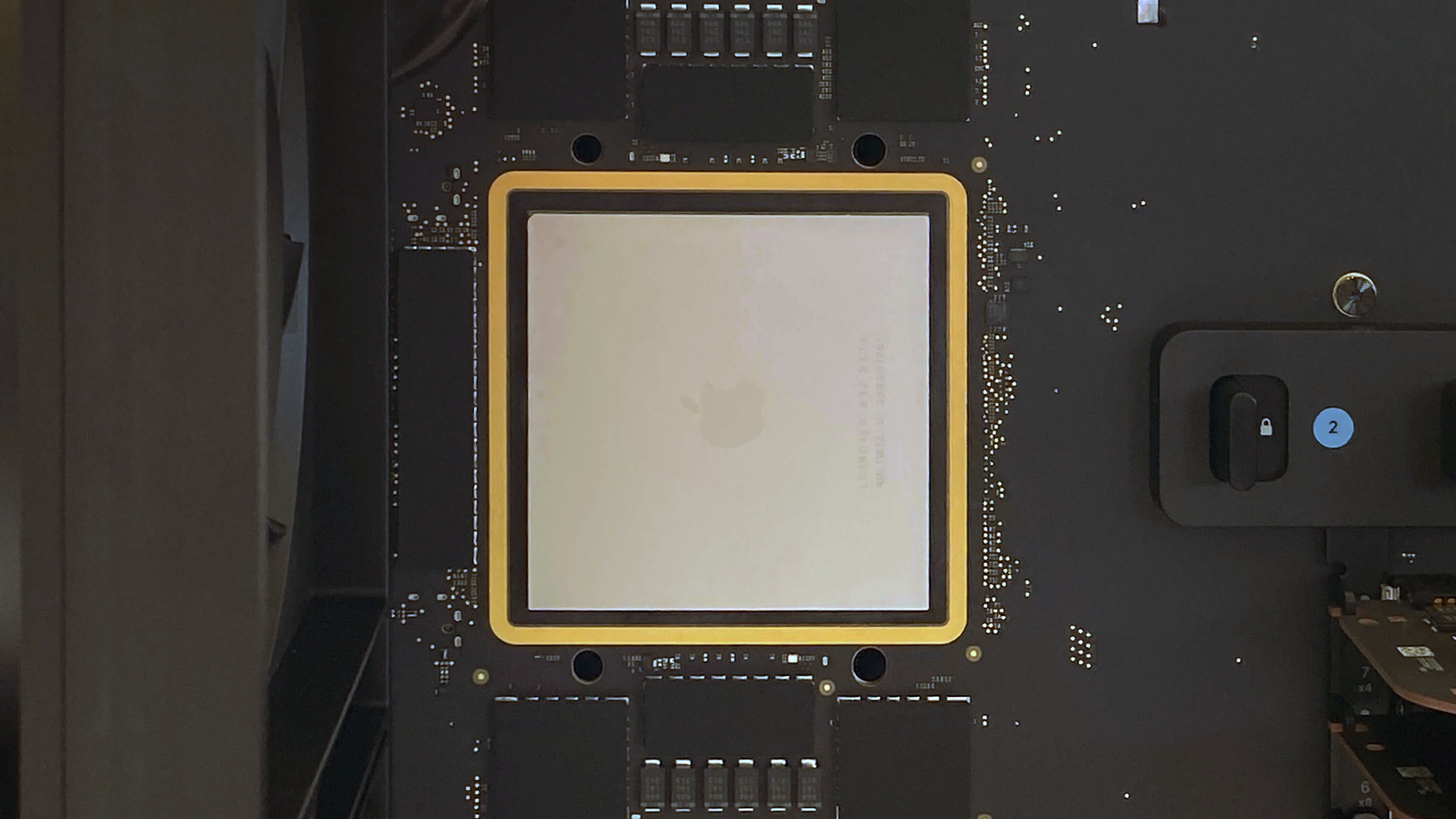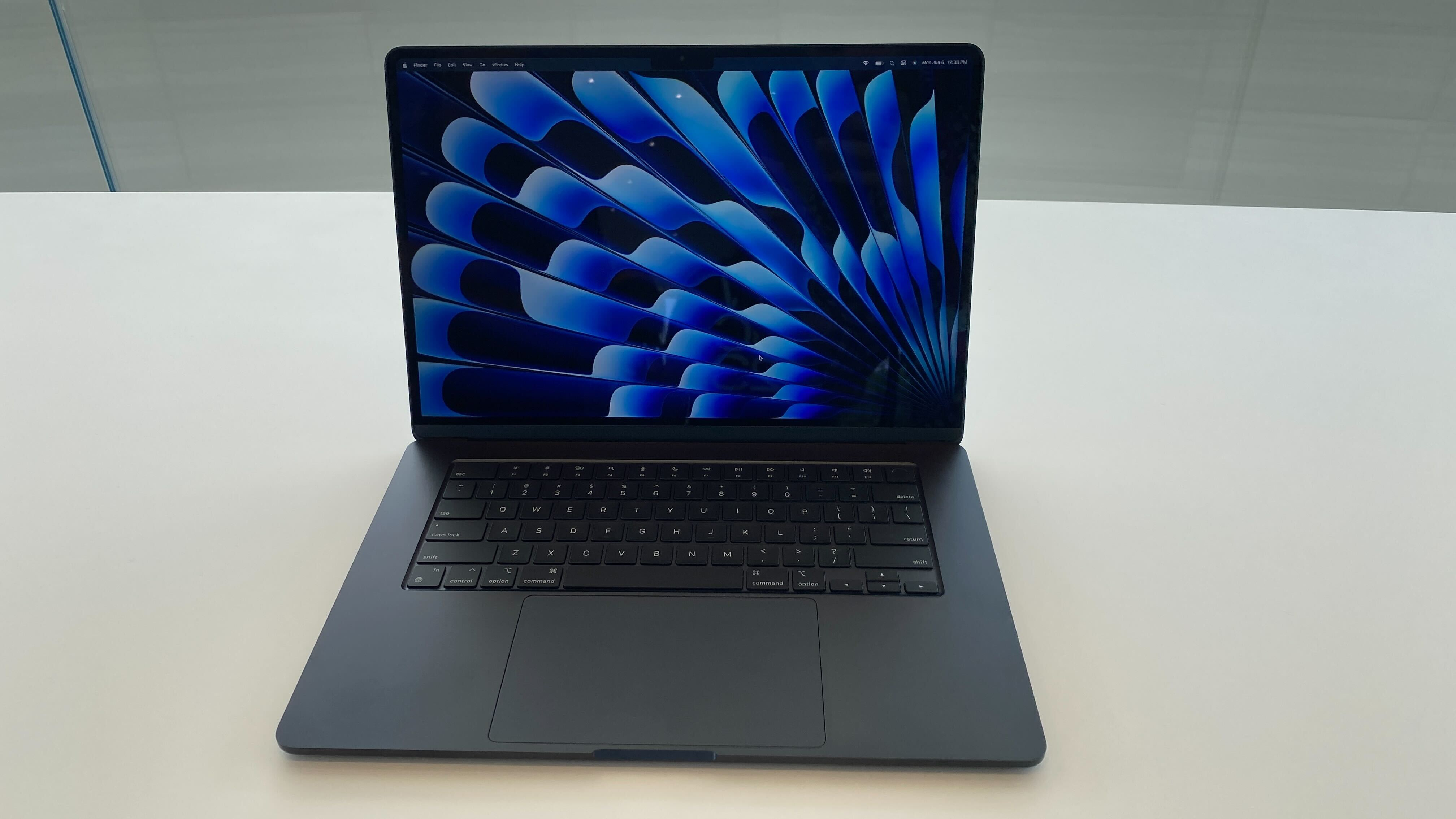With Its Silicon Transition Complete, Apple Seems to Have New Confidence in its Macs
Without Intel, Apple has control of its own destiny. What will it do?

In 2020, as Apple introduced the M1 system on a chip, the company said it would switch away from Intel over two years. Here in 2023, it took a bit longer than Apple forecasted, but with the new Mac Pro with M2 Ultra, Apple has every single one of its computers on its own SoCs. I'm not sure I've ever seen the company this confident about the Mac.
The Mac Pro is an odd duck. Of Apple's computers, it's far from the most popular among consumers, but it's extremely important to creatives who need lots of power and are willing to spend the money for it. As the most powerful, flexible system in Apple's stack, it sets a tone for the rest of the line. Without Intel, it feels as if Apple can now act without restraint.
At WWDC in Cupertino, Apple has the Mac Pro out in its hands-on area with no cooler. That's right — Apple had a chip shot ready for anyone with a camera. M2 Ultra, its most powerful chip ever, was getting a bit of a flex. (Let us not forget, the more attainable Mac Studio also has M2 Ultra. There are two shapes in which to get Apple's most powerful processor).
The lineup is now as follows:
M1 Macs
- 13-inch MacBook Air (entry level)
- iMac (24-inch)
M2 Macs
- Mac Mini (M2, M2 Pro)
- 13-inch MacBook Air
- 15-inch MacBook Air
- 13-inch MacBook Pro
- 14-inch MacBook Pro (M2 Pro, M2 Max)
- 16-inch MacBook Pro (M2 Max)
- Mac Pro (M2 Max, M2 Ultra)

Intel Macs
- Nothing to see here!
When will Apple upgrade the M1 models? Whenever it damn well pleases. That's kind of the point. Apple now controls not just the system, but the chip. Apple may sell systems, but it builds chips to power them. The two are intertwined, whether it's a laptop or a desktop.
And that's before considering the other places the M-series chips have popped up, including the iPad Air with M1 and iPad Pro with M2. Apple's Vision Pro will be powered by an M2 chip in combination with its new R1.
But we're on the Mac. Apple could update any of these systems whenever it wants. It can also hold one on an older process node as long as it needs, whether because that's what it thinks its customers want, or because that's what the supply chain allows. It makes that decision for itself.

Everyone I spoke to at Apple seemed thrilled to be over the hump. But now, it has to truly beat Intel, AMD, Qualcomm and others at the game. And if those companies outdo Apple, it has no one else to point the finger at.
Apple is trying its best here. The company can claim that you can game on its machines. I've tried it. Resident Evil Village runs great. Stray and No Man's Sky are here. Hideo Kojima showed up in the WWDC livestream to announce that Death Stranding: Director's Cut is coming to Mac. Apple is doing some heavy lifting to get games on its platform.
And Apple is also interweaving the Mac with the iPhone and iPad more than ever before with macOS Sonoma. Sure, I had widgets when I had a Mac running Mac OS X Leopard, but sharing between these devices is an acknowledgment that the Mac is an integral part of workflows that also include iPhones. And that's a level of interoperability other ecosystems can't match, though I appreciate Intel and Microsoft trying to get iPhone support in, they can't match Apple on making your phone and PC workspaces that are tied together.
Heck, using the Mac is a showcase feature of the Vision Pro. Want the most power? Use your Mac on an AR/VR headset. Who said the traditional computer is going away?
And with the Mac Pro, we see Apple can still be flexible, allowing for PCIe Gen 4 cards for I/O, storage, audio and more, even if graphics are no longer supported.
WWDC, as a developer conference, pushed hard on the Macs for Pros, like the Studio and the Pro, the company's two most expensive and most powerful machines. But the 15-inch MacBook Air is a version of Apple's best-selling notebooks. In fact, it's an addition to the MacBook line, which has way more sizes and models than Apple has offered in recent memory.
Some Apple fans may be upset to see that the 24-inch iMac is still on M1, or that a 27-inch model never came back. I feel that. But that's also the type of decision that Apple has more power to make now, more than ever. Short of fabbing its own chips, Apple has all of the power of what goes into a system, and when. And that means it can design a system around any chip in its arsenal.
For many years, I wondered if the Mac was a second thought, sitting in line behind the iPhone and the iPad. From WWDC, it's extensively clear that's not the case. With Apple using its own silicon across platforms, with interoperability on the hardware and software level, the Mac feels like a key player at Apple again.
Get Tom's Hardware's best news and in-depth reviews, straight to your inbox.
Andrew E. Freedman is a senior editor at Tom's Hardware focusing on laptops, desktops and gaming. He also keeps up with the latest news. A lover of all things gaming and tech, his previous work has shown up in Tom's Guide, Laptop Mag, Kotaku, PCMag and Complex, among others. Follow him on Threads @FreedmanAE and BlueSky @andrewfreedman.net. You can send him tips on Signal: andrewfreedman.01
-
bit_user Two key oversights, here:Reply
The new Mac Pro really falls short on max memory capacity and will surely lose on some benchmarks vs. 56-core and 64+-core Xeon W and Threadripper Pro workstations. It's basically just a Mac Studio in a big case, with a PCIe switch. They really fell short of a full Mac Pro replacement, in this generation.
Apple's cloud surely runs on mostly 3rd party CPUs & servers.
This makes declarations of "Mission Accomplished" feel a bit premature.
They could solve both problems by developing their own server CPU. Amazon, Google, and MS all have gone down that road, even for just their own internal cloud hosting purposes. Therefore, it seems quite plausible, if Apple can take care of both the above gaps, that they would do the same. -
atomicWAR Reply
Apple really needs to allow for dimms on their high end computers IMHO. We get its cheaper to solder everything on and close your hardware but there are users where memory capacity/upgradiblity will be make or break on their purchases. So for sure your totally on point with memory falling short and likely losing to 56 and 64 core workstations with larger memory allotments.bit_user said:Two key oversights, here:
The new Mac Pro really falls short on max memory capacity and will surely lose on some benchmarks vs. 56-core and 64+-core Xeon W and Threadripper Pro workstations. It's basically just a Mac Studio in a big case, with a PCIe switch. They really fell short of a full Mac Pro replacement, in this generation.
Apple's cloud surely runs on mostly 3rd party CPUs & servers.
This makes declarations of "Mission Accomplished" feel a bit premature.
They could solve both problems by developing their own server CPU. Amazon, Google, and MS all have gone down that road, even for just their own internal cloud hosting purposes. Therefore, it seems quite plausible, if Apple can take care of both the above gaps, that they would do the same. -
Geef Just looking at the top line:Reply
With Its Silicon Transition Complete, Apple Seems to Have New Confidence in its MacsThen glancing at the picture made me think of them doing something like having confidence a MAC tower case can survive a dump in a swimming pool. Look at the pic again and tell me that water outside doesn't look like a swimming pool at a glance. -
freedomfries Reply
Apple has been excelling at building great consumer devices, but has a terrible track record in the professional tool arena for the past twenty years, and I don't see this changing for several reasons:Admin said:Apple has completed its transition away from Intel. Now, it's in full control of its computer lineup.
With Its Silicon Transition Complete, Apple Seems to Have New Confidence in its Macs : Read more
-COST: While the PRO hardware is superb indeed, it costs a lot more than comparable platforms running Linux/Windows. Especially when you factor in the cost of keeping hardware up to date, and innovation cycles. Businesses are a lot more cost conscious than household consumers for tech stuff because they are running a business. No need to explain this.
-Software: I work in visual effects for film and TV. We arguably have some of the highest demands in terms of computing power. Also, we use a very diverse tool set. There are simply too many applications that do not perform well enough (for various reasons), or at all, on Mac OS. Because of this, and the cost of Apple hardware, the vast majority of studios run Windows/NIX platforms and use workstations that constantly get upgraded. Apple has made many attempts to make inroads in this industry, with a track record of failure to gain a foot hold. They bought Shake, the premium compositing software at the time, and attempted to draw people to buy Mac hardware in order to run Shake by doubling the license price of other platforms. This resulted in Shake being abandoned and paved the way for Nuke to gain supremacy. Shake development died off within a couple years. Then they bought Final Cut Pro, the gold standard of video editing platforms that nearly EVERYONE used. Today, Avid and Premiere hold the market. Apple effectively sank the most popular video editing tool in the world.
Apple's sandbox business model, where they want to control the software, hardware and all peripherals, creates huge lags in development cycles. They always manage to release a new Mac that seems to be superior to PC's for about 6months, and then PC's catch up and these expensive Macs are behind the curve for a couple years, until Apple refreshes the lineup. That's been the current track record. Now if this were to change, who knows. As it stands, businesses who need to watch their margins will probably look elsewhere, and this will leave PC's with the market lion's share.
The day of the Mac being the supreme multimedia creation platform are over. And that puts the viability of Mac Pro hardware in question. PC's have an embarrassment of choices for hardware and software better tailored to individual needs than you can find in the Apple world. GPU's are an essential part of the equation for high end workstations today. I'm not going to spend a premium for a mac "versioned" GPU built by a third party when I can get the same tool for less running Windows or Linux. Having a slick iPhone or tablet at home is one thing, but I really don't care what my workstation looks like. It's a tool and as long as it does the job well and doesn't cost me a fortune, that's all I ask for.
And for print work, or Audio work, a simple desktop PC can handle all this with ease these days. You can get Pro Tools on Windows just as well. Macs were popular when all that auxiliary hardware was clearly better on Mac OS, and easier to configure, but this is a thing of the past. Today, Mac Pros are beautiful, expensive beasts that do not bring much of a business proposition to the table. Apple would need to match its pricing to that of PC's in order to gain market share. -
bit_user Reply
Cool. I've been out of that industry for 2+ decades, but it was nice to hear your take. I left around the time when Avid was transitioning from Mac to Windows NT. I used to work with some ex-Avid employees who told me about when Apple first approached them and convinced them to release Avid on Mac (prior to that, they were developing it for some workstation...).freedomfries said:I work in visual effects for film and TV.
Anyway, thanks for taking the time to write all of that. -
crimsonfilms Replyfreedomfries said:Then they bought Final Cut Pro, the gold standard of video editing platforms that nearly EVERYONE used. Today, Avid and Premiere hold the market. Apple effectively sank the most popular video editing tool in the world.
Correction. Final Cut was designed by Macromedia (the people that invented Flash). Before it was publicly released it was bought and explicitly designed for Mac. It was not the Gold Standard for editing. That was Avid. Long story short, Avid was always Mac but hardware design choices by Apple forced the company to make a Windows version. Which pissed off Steve Jobs. Final Cut was their answer - Mac only editing software.
Apple made Final Cut to was the most popular editing software. FCP 7 was the peak. FCP X turned off many existing users that migrated back to Avid or now use Adobe Premiere.
In FX, yes, Windows and Linux are very popular. Mac reigns supreme in the creative nonlinear editing for TV and film - at least in Hollywood, NY, Atlanta, Canada, London, etc. And lot of independent film makers. -
Sippincider ReplyWithout Intel, Apple has control of its own destiny. What will it do?
Hopefully not repeat PowerPC!
And for God's sake keep the desktop line current. The M1 iMac needed a bump a while ago, and the Mac Pro had better get regular updates now. -
TEAMSWITCHER Reply
Visual Effects for Film and TV is such a frick'n niche market. Apple was smart to abandon that for the consumer market which is back to their roots. Here in America you can go onto any college campus and the dominant laptop computer .. by a wide margin .. is the Mac. Add that to the fact that PC's have ZERO footprint in the smart phone market .. you begin to see just how smart Apple was to kick you to the curb.... You were holding Apple back...freedomfries said:Apple has been excelling at building great consumer devices, but has a terrible track record in the professional tool arena for the past twenty years, and I don't see this changing for several reasons:
-COST: While the PRO hardware is superb indeed, it cots a lot more than comparable platforms running Linux/Windows. Especially when you factor in the cost of keeping hardware up to date, and innovation cycles. Businesses are a lot more cost conscious than household consumers for tech stuff because they are running a business. No need to explain this.
-Software: I work in visual effects for film and TV. We arguably have some of the highest demands in terms of computing power. Also, we use a very diverse tool set. There are simply too many applications that do not perform well enough (for various reasons), or at all, on Mac OS. Because of this, and the cost of Apple hardware, the vast majority of studios run Windows/NIX platforms and use workstations that constantly get upgraded. Apple has made many attempts to make inroads in this industry, with a track record of failure to gain a foot hold. They bought Shake, the premium compositing software at the time, and attempted to draw people to buy Mac hardware in order to run Shake by doubling the license price of other platforms. This resulted in Shake being abandoned and paved the way for Nuke to gain supremacy. Shake development died off within a couple years. Then they bought Final Cut Pro, the gold standard of video editing platforms that nearly EVERYONE used. Today, Avid and Premiere hold the market. Apple effectively sank the most popular video editing tool in the world.
Apple's sandbox business model, where they want to control the software, hardware and all peripherals, creates huge lags in development cycles. They always manage to release a new Mac that seems to be superior to PC's for about 6months, and then PC's catch up and these expensive Macs are behind the curve for a couple years, until Apple refreshes the lineup. That's been the current track record. Now if this were to change, who knows. As it stands, businesses who need to watch their margins will probably look elsewhere, and this will leave PC's with the market lion's share.
The day of the Mac being the supreme multimedia creation platform are over. And that puts the viability of Mac Pro hardware in question. PC's have an embarrassment of choices for hardware and software better tailored to individual needs than you can find in the Apple world. GPU's are an essential part of the equation for high end workstations today. I'm not going to spend a premium for a mac "versioned" GPU built by a third party when I can get the same tool for less running Windows or Linux. Having a slick iPhone or tablet at home is one thing, but I really don't care what my workstation looks like. It's a tool and as long as it does the job well and doesn't cost me a fortune, that's all I ask for.
And for print work, or Audio work, a simple desktop PC can handle all this with ease these days. You can get Pro Tools on Windows just as well. Macs were popular when all that auxiliary hardware was clearly better on Mac OS, and easier to configure, but this is a thing of the past. Today, Mac Pros are beautiful, expensive beasts that do not bring much of a business proposition to the table. Apple would need to match its pricing to that of PC's in order to gain market share. -
kdw75 I notice how Steve Jobs is adamant about making it easy for the user to upgrade components in the Mac Pro as he shows of the easy open side. I am glad to see that Apple prioritizes that.Reply -
UWguy Reply
You took the words right out of my mouth - Power PC 2.0Sippincider said:Hopefully not repeat PowerPC!
And for God's sake keep the desktop line current. The M1 iMac needed a bump a while ago, and the Mac Pro had better get regular updates now.
The Mac Pro is just such a niche product. PCs simply offer way more power, flexibility, and upgradability for far less cost. With the rapid evolution of hardware why (unless there is a very specific application) would somebody spend bouco dinero on something that is literally no longer top tier in 6 months? Does apple even make a profit on these? (not that it really matters I suppose)
